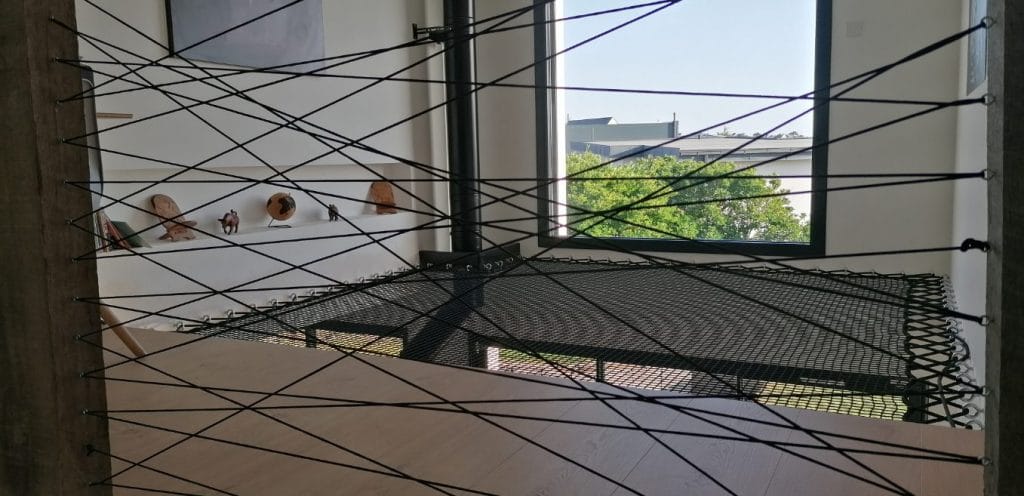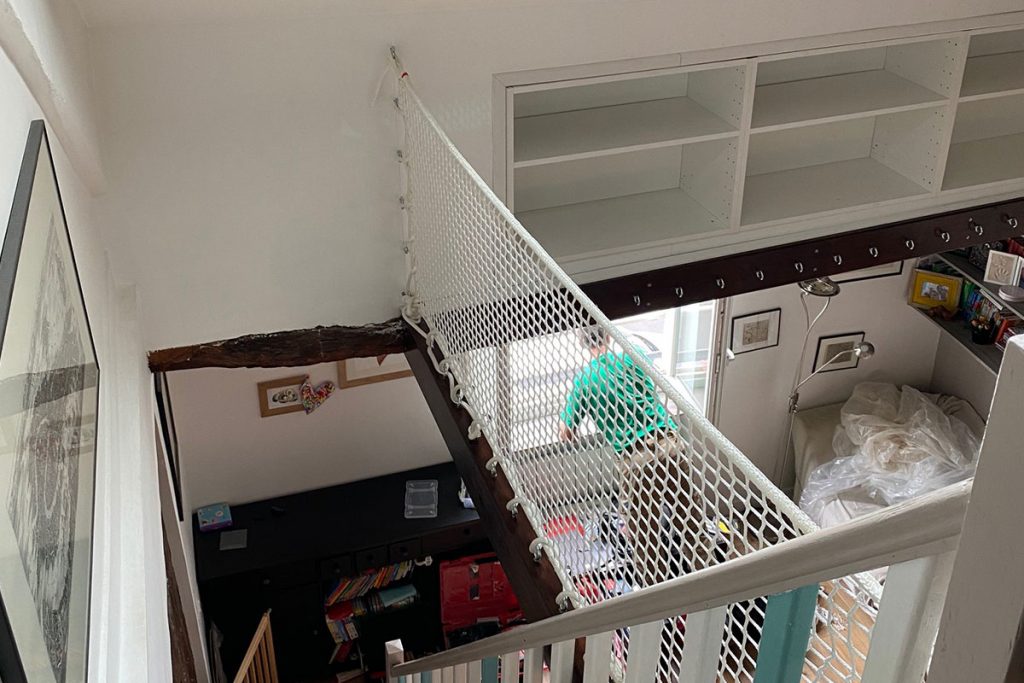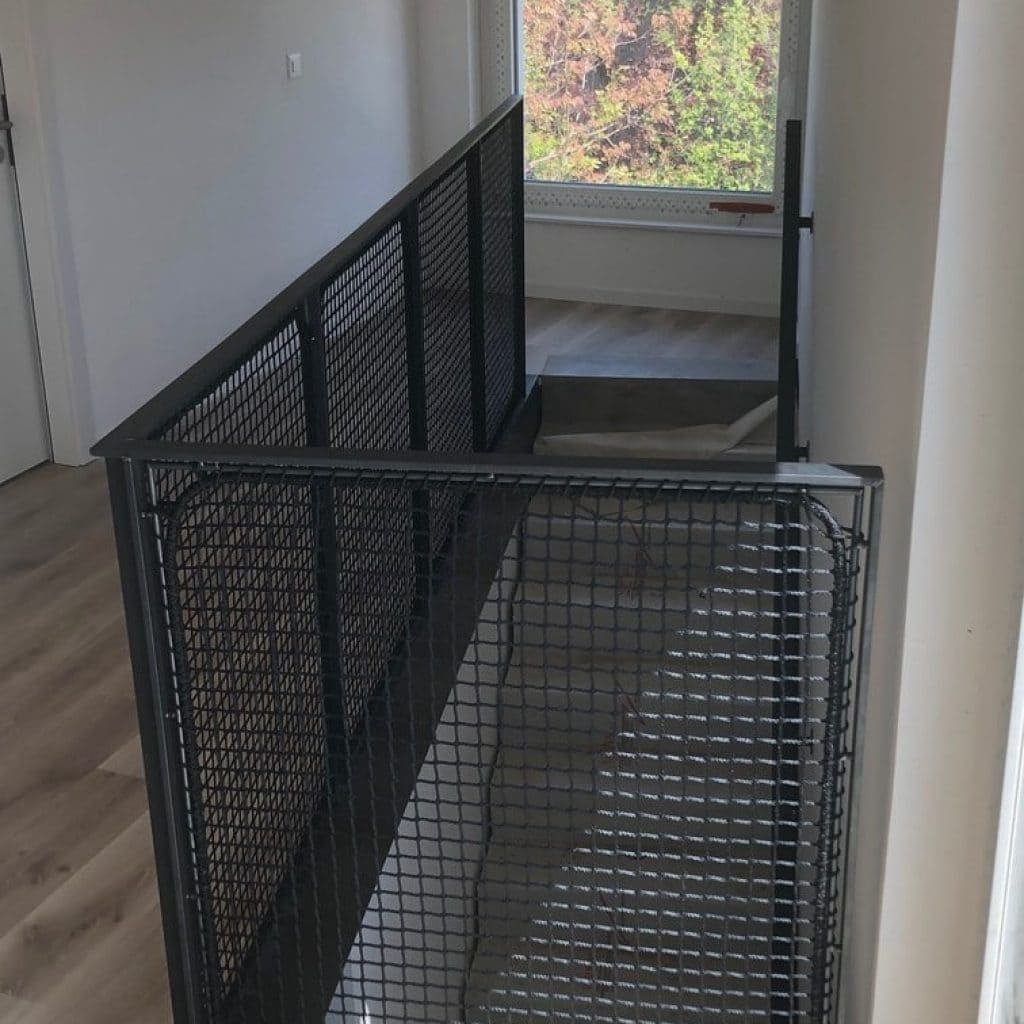The safety railing, generally installed “horizontally, is there to secure an ‘empty’ space and prevent falls. And when we talk about safety and aesthetics, we inevitably mean living space netting. At”Feelnets, our indoor and outdoor living space “nets” offer maximum resistance to weight and time. In addition to helping make certain areas of the house safer, such as a terrace, a mezzanine, a staircase or an attic, these living space “nets are also very stylish and allow you to maintain all the brightness inside and outside your home. But what are the standards for a safety railing? Which living space net to choose for a safety railing? And how to install a safety net railing? Feelnets tells you more”…
The Advantages of Choosing a Living Space Net for your Safety Railing

Let’s first talk about safety. Contrary to what its very airy appearance might suggest, the living space net is a very wise choice for securing a living space. Indeed, a Feelnets living space net has a mesh resistance of 200 kg / m². In “horizontal” mode, it can support the weight of 5 adults. In vertical mode, it is therefore totally optimized to ensure the safety of a railing, just like a steel net would do.
As for aesthetics, the indoor living space net brings to a safety railing an aesthetic, playful and original added value. It lets all the light through and thus allows you to maintain very warm living spaces. The net can also be more discreet than a wooden, iron or glass railing. And for the choice of mesh, it is now possible to opt for different colors, with white, black and red being the most popular.
Indoors: a Living Space Safety Net Railing for a Staircase, a Mezzanine…
The applications of a living space net as a safety railing are multiple indoors. One of the most frequent is surely along a staircase. The safety net railing can then be placed on a banister to make it even more secure. Or it can be perfectly placed all along the staircase, from floor to ceiling, sometimes allowing to hide the staircase a bit, while securing it and letting light through.
When you have a mezzanine in your house, it is often essential to create a safety railing. The living space net is again very suitable here as it will increase the safety of this living space, while keeping it open to the rest of the house.
Finally, to prevent any falls from a high bed, it is also possible to place a custom-made living space net all along it. A fun and safe solution for children.
Outdoors: a Safety Net Railing for a Staircase, a Terrace…
Same use of a living space net to create a safety railing on an outdoor staircase. And as Feelnets living space nets are custom-made, you can install it on a straight staircase, spiral staircase, quarter-turn…
Outdoors, it’s on a balcony or terrace that the safety net railing will be most used. You can thus place it on an already existing wooden or steel railing. While maintaining perfect visibility on your outdoor space, the living space safety net railing allows to fill a void and avoid all falls.
Ideally, for your safety net railing, you should opt for a mesh that is rigid enough to resist wind. But never too tight, so as not to obstruct the view.
Current Standards for Installing a Safety Railing
As explained on the Buldi and Système D websites, there are very precise standards in terms of safety railings. And very important since in case of an accident (such as a person falling), failure to comply with these standards engages the responsibility of the property owner.
There are two main safety standards that govern the installation of guardrails at home: the NF P01-012 and NF P01-013 standards. The NF P01-012 standard determines the regulatory dimensions of the guardrail and how it should be installed. The NF P01-013 standard corresponds to the resistance of railings in terms of impacts or implementation.
It is mandatory to install a guardrail when there is a risk of falling from a height of more than 1 m.
The NF P01-012 standard distinguishes between thin guardrails with a thickness less than or equal to 20 cm and thick guardrails with a thickness greater than 20 cm. Thin structures must be at least 1 m high. As soon as the guardrail is more than 25 cm “thick, the height can be reduced to” 70 cm maximum.
The gap between the bars must be a maximum of 11 cm for vertical balusters and 18 cm for horizontal or oblique infill (ramp guardrail). The safety zone, which extends from the foot of the guardrail to a height of 45 cm, must not be able to serve as a ladder for children. It must therefore be equipped with baseboards.
While respecting these rules, you can then choose the guardrail of your choice: with balusters, with stainless steel cables, a balustrade with infill, a railing on a low wall… Then you can apply your residential safety net on top to ensure even more safety for your guardrail.
How to Properly Install and Choose your Guardrail Net

Feelnets offers colored ropes (red/black/white or grey) of different diameters: 10mm, 8mm or 6mm. Generally, 6mm or 8mm rope is chosen for vertical guardrail nets. Regarding mesh size, Feelnets gives you a choice between 13 x 13 mm and 30 x 30 mm. The choice is then made based on the desire to allow more or less light to pass through.
All our custom-made residential nets are braided, which gives them a flatter appearance and improves their aesthetics.
For guardrails, there are open eyebolts allowing direct attachment of the net meshes, without lacing rope. Once the frame is in place, installation is very simple and requires little time. Feelnets recommends a solid frame.
For installation, Feelnets provides you with detailed step-by-step installation instructions. But if you don’t want to install your guardrail net yourself, our partners throughout France will be at your disposal to carry out the installation of your net.



